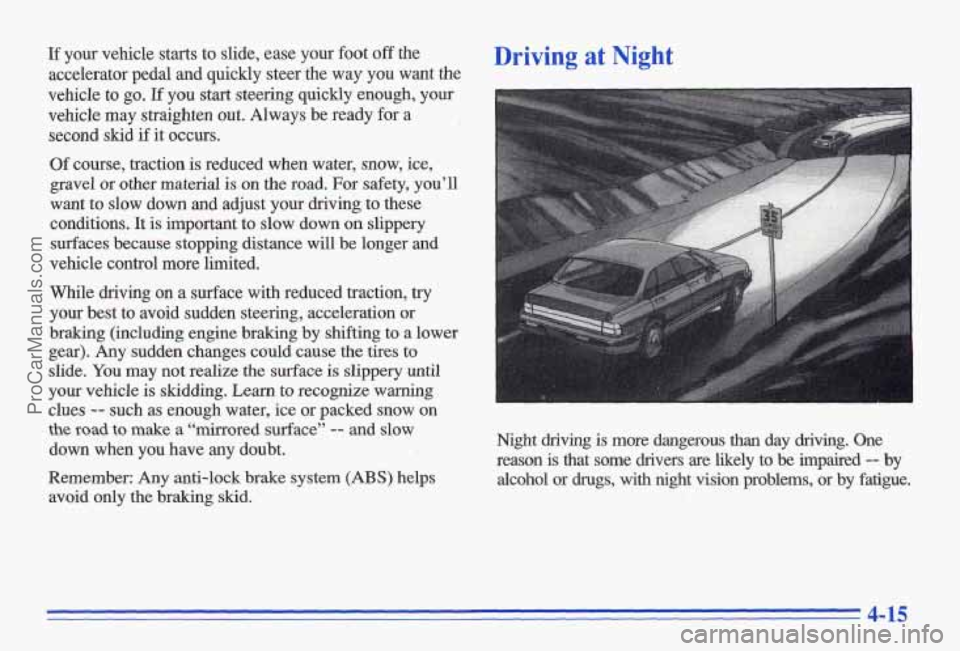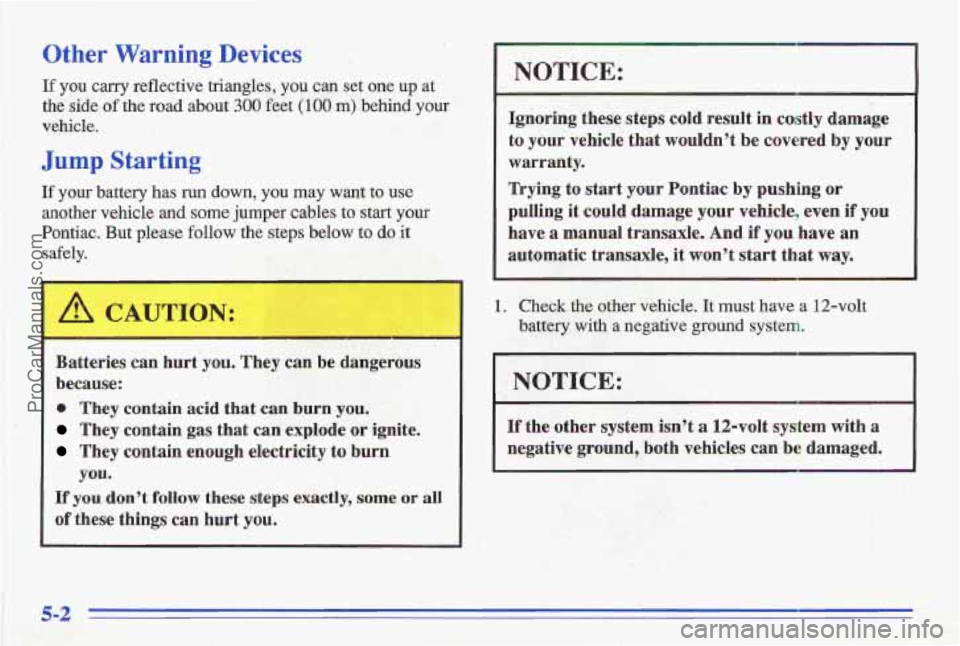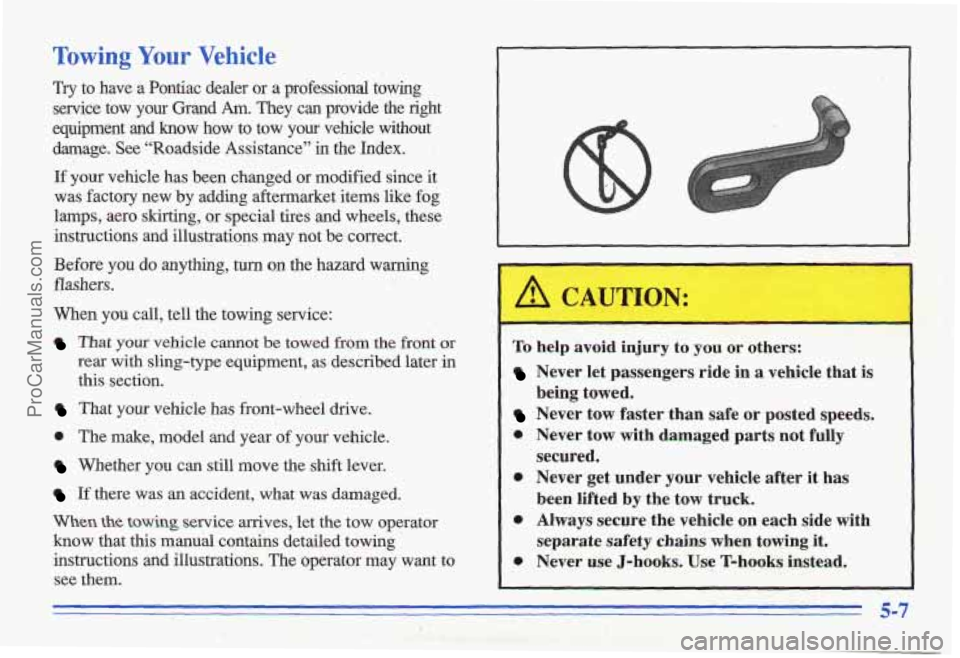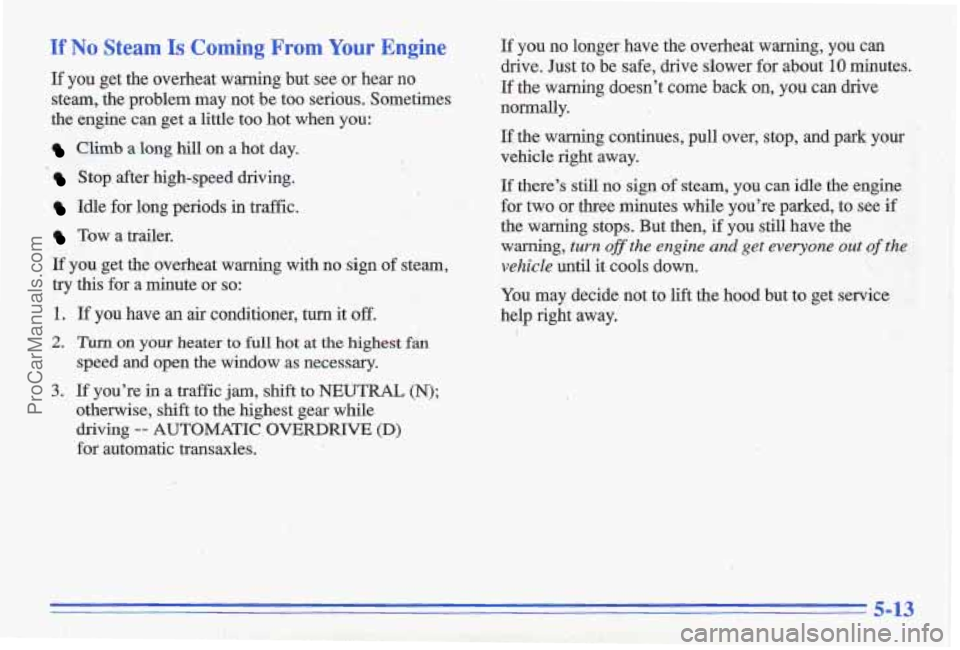Page 163 of 356

If your vehicle starts to slide, ease your foot off the
accelerator pedal and quickly steer the way you want the
vehicle to
go. If you start steering quickly enough, your
vehicle may straighten out. Always be ready for a
second skid
if it occurs.
Driving at Night
Of course, traction is reduced when water, snow, ice,
gravel or other material is on the road, For safety, you’ll
want
to slow down and adjust your driving to these
conditions. It is important to slow down
on slippery
surfaces because stopping distance will be longer and
vehicle control more limited.
While driving on a surface with reduced traction, try
your best to avoid sudden steering, acceleration or
braking (including engine braking by shifting to
a lower
gear). Any sudden changes could cause
the tires to
slide. You may not realize the surface is slippery until
your vehicle is skidding. Learn to recognize warning
clues
-- such as enough water, ice or packed snow on
the road to make a “mirrored surface” -- and slow
down when you have any doubt.
Remember: Any anti-lock brake system
(ABS) helps alcohol or drugs, with night vision problems, or by fatigue.
avoid only the braking skid. Night driving
is more dangerous than day driving. One
reason
is that some drivers are likely to be impaired -- by
4-15
ProCarManuals.com
Page 168 of 356
City Driving Here are ways to increase your safety in city driving:
Know the best way to get to where you are going.
Get a city map and plan your trip into an unknown
part of the city just as you would for a cross-country
Try to use the freeways that rim and crisscross most
large cities. You’ll save
time and energy, (See the
next part, “Freeway
Driving.”) I.
Treat a green light as a warning signal. A traffic light
is there because the corner is busy enough to need it.
When a light turns green, and just before you start to
move, check both ways for vehicles that have not
cleared the intersection or may be running the red
light.
trip.
One of the biggest problems with city streets is the
amount of traffic on them. You’ll want tu watch out for
what the other drivers are doing and pay attention to
traffic signals,
ProCarManuals.com
Page 173 of 356
Winter Driving
Here are some tips for winter driving:
Have your Pontiac in good shape for winter.
a You may want to put winter emergency supplies in
your trunk.
Include an ice scraper, a small brush or broom, a supply
of windshield washer fluid, a rag, some winter outer
clothing, a small shovel, a flashlight, a red cloth and a
couple of reflective warning triangles. And,
if you will
be driving under severe conditions, include a small bag of sand, a piece of old carpet
or a couple of burlap bags
to help provide traction. Be sure you properly secure
these items in
your vehicle.
ProCarManuals.com
Page 191 of 356
Section 5 Problems on the Road
Here you’ll find what to do about some problems that
can occur on the road.
Hazard Warning Flashers
Your hazard warning flashers let you warn others. They
also let police know you have a problem. Your front
and
rear turn signal lamps will flash on and off.
Move the switch to the
right to
make your
front and rear turn
Your hazard warning flashers work no matter what
position
your key is in, and even if the key isn’t in.
To turn off the flashers, move the switch to the left.
When the hazard warning flashers are on, your turn
signals won’t work.
5-1
ProCarManuals.com
Page 192 of 356

Other Warning Devices
If you carry reflective triangles, you can set one up at
the side
of the road about 300 feet (100 m) behind your
vehicle.
Jump Starting
If your battery has run down, you may want to use
another vehicle
and some jumper cables to start your
Pontiac. But please follow the steps below
to do it
safely.
Batteries can hurt'you. They can be dangerous
because:
0 They contain acid that can burn you.
They contain gas that can explode or ignite,
They contain enough electricity to burn
you.
If you don't follow these steps exactly, some or all
of these things can hurt you.
I NOTICE:
Ignoring these steps cold result in costly damage
to your vehicle that wouldn't be covered
by your
warranty.
"kying to start your Pontiac by pushing or
pulling it could damage your vehicle, even if you
have
a manual transaxle. And if you have an
automatic transaxle, it won't Start that way.
1. Check.the other vehicle. It must have a 12-volt
battery with
a negativ'e ground system.
I NOTICE:
If the other system isn't a 12-volt system with a
negative ground, both vehicles can be damaged.
5-2
..
ProCarManuals.com
Page 197 of 356

Towing Your Vehicle
Try to have a Pontiac dealer or a professional towing
service tow your Grand
Am. They can provide the right
equipment and know how to tow
your vehicle without
damage. See “Roadside Assistance”
in the Index.
If your vehicle has been changed or modified since it
was factory new by adding aftermaxket items like fog
lamps, aero skirting, or special tires and wheels, these
instructions and illustrations may not be’correct.
Before
you do anything, turn on the hazard warning
flashers.
When you call, tell the towing service:
That your vehicle cannot be towed from the front or
rear with sling-type equipment, as described later in
this section.
That your vehicle has front-wheel drive.
0 The make, model and year of your vehicle.
Whether you can still move the shift lever.
If there was an accident, what was damaged.
When the towing service arrives, let the tow operator
know that this manual contains detailed towing
instructions and illustrations. The operator may want to see them.
L
,I A CAUTION:
I To help avoid injury to you or others:
Never let passengers ride in a vehicle that is
Never tow faster than safe or posted speeds.
0 Never tow with damaged parts not fully
secured.
0 Never get under your vehicle after it has
been lifted
by the tow truck.
0 Always secure the vehicle on each side with
separate
safety chains when towing it.
0 Never use J-hooks. Use T-hooks instead.
being towed.
5-7
ProCarManuals.com
Page 202 of 356
Engine Overheating .
You will find a coolant temperature g.age and a low
coolant warning light on your Pontiac’s instrument
panel. See
“Engine Coolant Temperature Gage” and
“Low Coolant Warning Light” in the Index.
If Steam Is Coming From Your Engine
Steam from an overheated engine can burn you
badly, even if you just open the hood. Stay away
from the engine if you
see or hear steam coming
~ from it. Just turn it off and get everyone away
from the vehicle until it cools down. Wait until
there
is no sign of steam or coolant before
opening the
hood,
If you keep driving when your engine is
overheated, the liquids in it can catch fire, You or
others could
be badly burned. Stop your engine if
it overheats, and get out of the vehicle until the
engine is cool.
1 NOTICE:
~ ~~
If your engine catches fire because you keep
driving with no coolant, your vehicle can be
badly damaged. The costly repairs would not be
covered by your warranty.
5-12
ProCarManuals.com
Page 203 of 356

If No Steam Is Coming From Your Engine
If you get the overheat warning but see or hear no
steam, the problem may not b'e too serious. Sometimes
the engine can get a little too hot when you:
Cbb a long hill on a hot day.
' Stop after high-speed driving.
Idle for long periods in traffic.
Tow a trailer.
If you get the overheat warning with no sign of steam,
try this for a minute or so:
1. If you have an air conditioner, turn it off.
2. Turn on your heater to full hot at the highest fan
speed and open the window as necessary.
3. If you're in a traffic jam, shift to NEUTRAL (N);
otherwise, shift to the highest gear while
driving
-- AUTOMATIC OVERDRIVE (D)
for automatic transaxles. ;+, 1; , !, -.,.r., . .-I? ,*:, I,3 : 1 I' ' . . :4?,+ . .I .
If you no longer have the overheat warning, you can
drive. Just to be safe, drive slower for about 10 minutes.
If the warning doesn't come back on, you can drive
normally.
If the warning continues, pull over, stop, and park your
vehicle right away.
If there's still no sign of steam, you can idle the engine
for two or three minutes while you're parked, to see
if
the warning stops. But then, if you still have the
warning,
turn ojf the engine and get everyone out of the
vehicle
until it cools down.
You may decide not .to lift the hood but to get service
help right 'away.
5-13
ProCarManuals.com